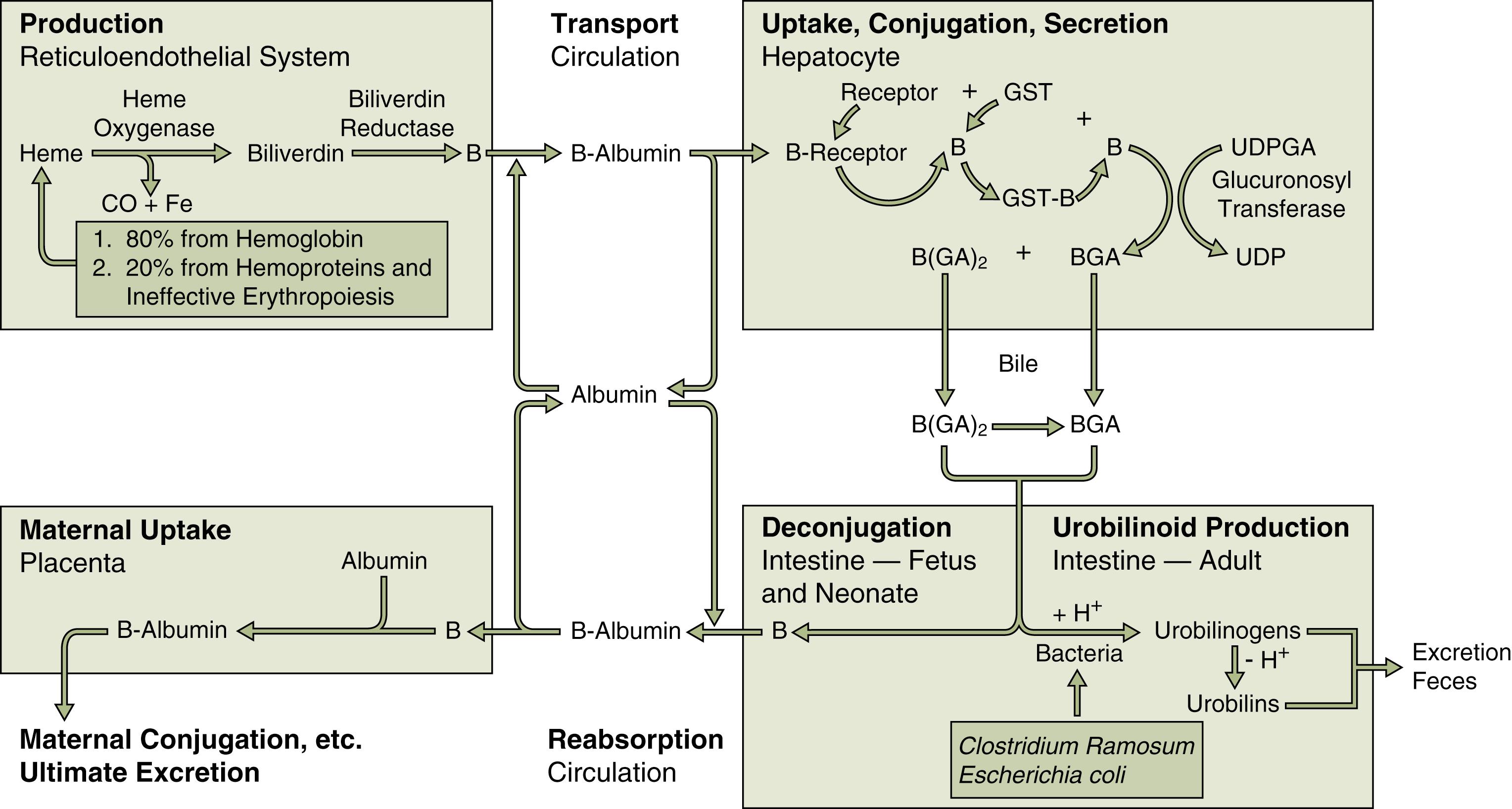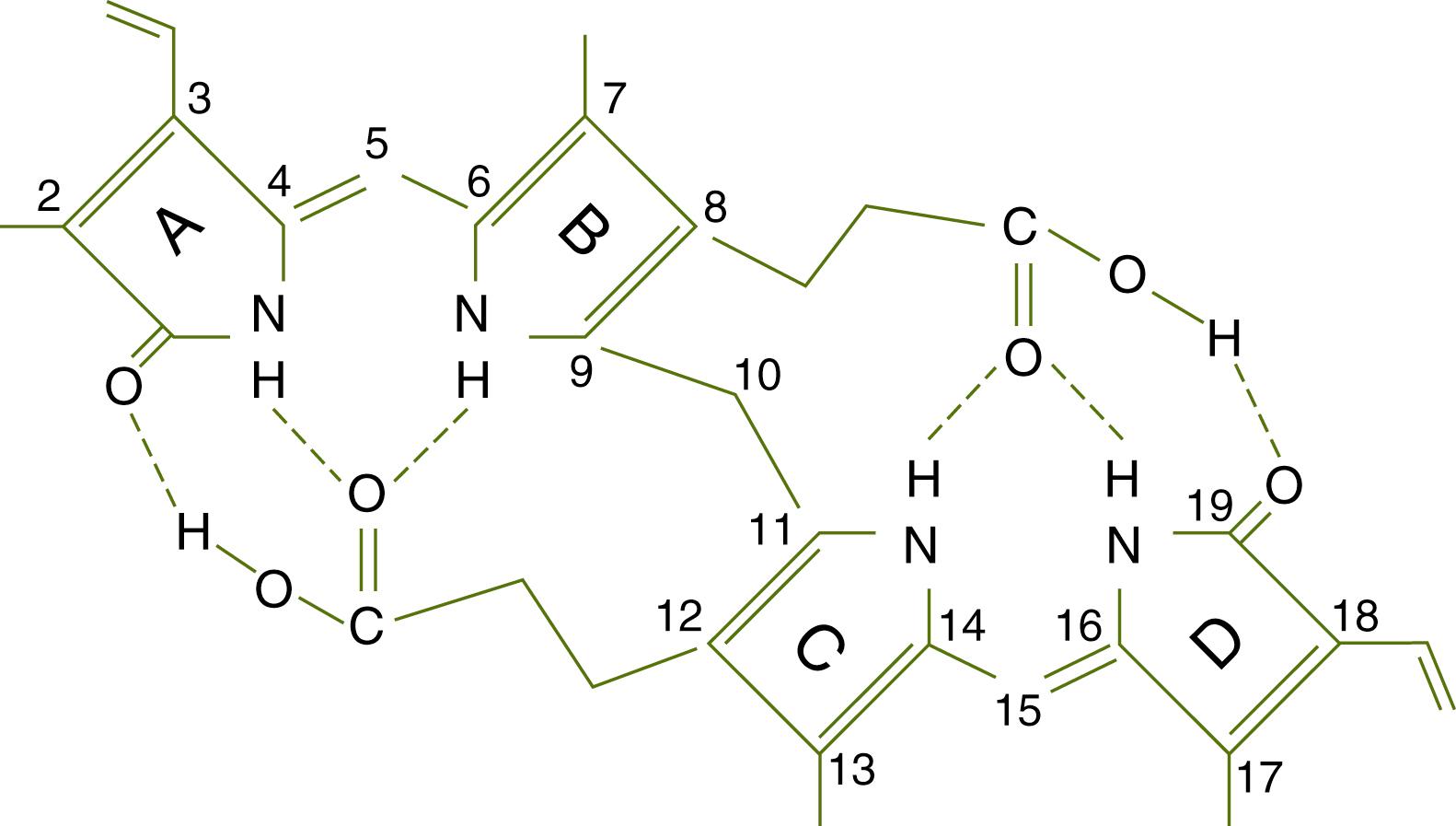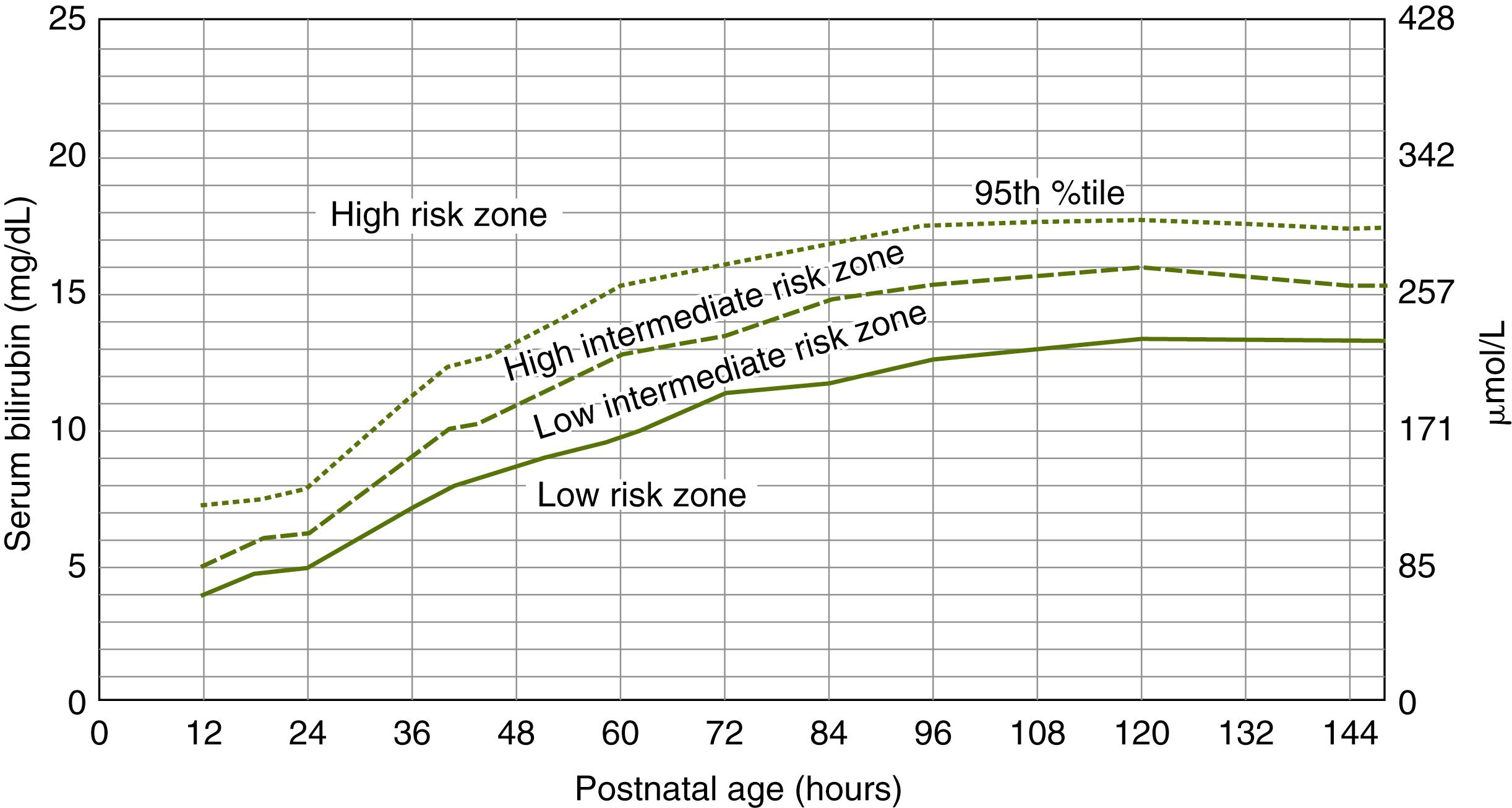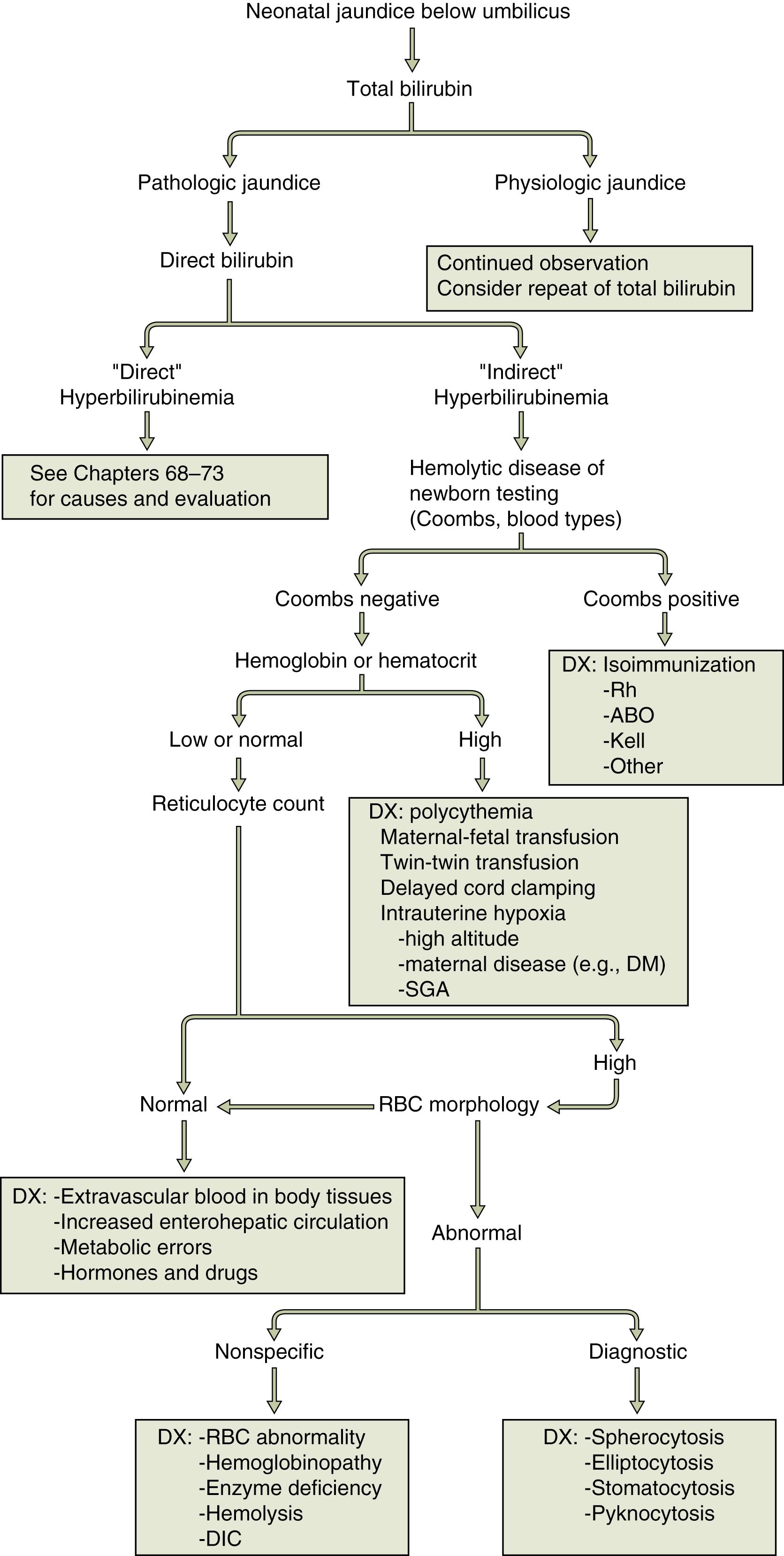Physical Address
304 North Cardinal St.
Dorchester Center, MA 02124
The term jaundice originated from the French jaune, which means “yellow.” Jaundice, or icterus (from the Greek ikteros ), refers to the yellow discoloration of the skin, sclerae, and other tissues caused by deposition of the bile pigment bilirubin. Jaundice is a sign that the serum bilirubin concentration has risen above normal levels (approximately 1.4 mg/dL after 6 months of age; 1 mg/dL = 17 mmol/L). The intensity of the yellow color is related directly to the level of serum bilirubin and the related degree of deposition of bilirubin into the extravascular tissues. This chapter will focus on causes of unconjugated hyperbilirubinemia resulting in jaundice.
The term bilirubin is derived from Latin ( bilis , bile; ruber , red) and was used in 1864 by Städeler to describe the red-colored bile pigment. Bilirubin is formed from the degradation of heme-containing compounds ( Fig. 16.1 ). The largest source for the production of bilirubin is hemoglobin. However, other heme-containing proteins are also degraded to bilirubin, including the cytochromes, catalases, tryptophan pyrrolase, and muscle myoglobin.

The formation of bilirubin is accomplished by cleavage of the tetrapyrrole ring of protoheme (protoporphyrin IX), which results in a linear tetrapyrrole. The first enzyme system involved in the formation of bilirubin is microsomal heme oxygenase. It is located primarily in the reticuloendothelial tissues and to a lesser degree in tissue macrophages and intestinal epithelium. This enzyme system results in reduction of the porphyrin iron (Fe 3+ to Fe 2+ ) and hydroxylation of the α-methine (=C–) carbon. This α-carbon is then oxidatively excised from the tetrapyrrole ring, yielding carbon monoxide. This excision opens the ring structure and is associated with oxygenation of the two carbons adjacent to the site of cleavage. The cleaved α-carbon is excreted as carbon monoxide, and the released iron can be reused by the body. The resultant linear tetrapyrrole is biliverdin IXα. The central (C10) carbon on biliverdin IXα is then reduced from a methine to a methylene group (–CH 2 –), thus forming bilirubin IXα. This is accomplished by the cytosolic enzyme biliverdin reductase. The ubiquity of this enzyme results in very little biliverdin ever being present in the circulation.
Bilirubin formation can be assessed by measurement of carbon monoxide production. Such assessments indicate that the daily production rate of bilirubin is 6 to 8 mg/kg per 24 hours in healthy, full-term infants and 3 to 4 mg/kg per 24 hours in healthy adults. , In mammals, approximately 80% of bilirubin produced daily originates from hemoglobin. Degradation of hepatic and renal heme appears to account for most of the remaining 20%, reflecting the very rapid turnover of certain of these heme proteins. Although the precise fate of myoglobin heme is unknown, its turnover appears to be so slow as to be relatively insignificant.
Catabolism of hemoglobin occurs largely from the sequestration of erythrocytes at the end of their life span (120 days in adult humans, 90 days in newborns, and 50 to 60 days in rats). A small fraction of newly synthesized hemoglobin is degraded in the bone marrow. This process, termed ineffective erythropoiesis , normally represents less than 3% of daily bilirubin production but may be substantially increased in persons with hemoglobinopathies, vitamin deficiencies, or heavy metal intoxication. Infants produce more bilirubin per unit body weight because their red blood cell (RBC) mass is greater and their RBC life span is shorter. In addition, hepatic heme proteins represent a larger fraction of total body weight in infants.
Bilirubin requires biotransformation to more water-soluble derivatives before excretion from the body. Bilirubin is not linear but rather has extensive internal hydrogen bonding, as shown in Fig. 16.2 . The internal hydrogen bonding of bilirubin makes the molecule extremely hydrophobic and insoluble in aqueous media. Knowledge of this stereochemistry is important for understanding phototherapy. When bilirubin is transported from its sites of production to the liver for excretion, a carrier molecule is necessary. Albumin serves this purpose and has a very high affinity for bilirubin (affinity constant ∼10 8 ). Bilirubin is taken up into the hepatocyte from the hepatic sinusoids by either passive diffusion or a high-affinity transport protein in the basolateral plasma membrane known as organic anion transporting polypeptide 2 (OATP1B1 transporter protein). OATP1B1 also transports bilirubin glucuronides, bromosulfophthalein, , and various drugs.

Once within the aqueous environment of the hepatocyte, bilirubin is again bound by a protein carrier, glutathione S -transferase. This is a family of cytosolic proteins that have enzymatic activity and that bind nonsubstrate ligands. Although the affinity of purified glutathione S -transferase for bilirubin is less than that of albumin, this compound is believed to be of importance in preventing bilirubin and its conjugates from refluxing into the circulation. Bilirubin is conjugated with glucuronic acid of the hepatocyte. The glucuronic acid donor is uridine diphosphate glucuronic acid (UDP-glucuronic acid). The enzyme responsible for this conjugation is bilirubin glucuronosyltransferase (BGT). Catalysis of bilirubin by BGT results in both monoglucuronides and diglucuronides of bilirubin (bilirubin monoglucuronide [BMGs] and BDGs, respectively). This conjugation disrupts the internal hydrogen bonding of bilirubin, and the resulting glucuronide conjugates are more water soluble. BGT activity for bilirubin can be induced by narcotics, anticonvulsants, contraceptive steroids, and bilirubin itself. Alternatively, BGT activity can be decreased by caloric and protein restriction. The specific isoform responsible for bilirubin conjugation is UGT1A1, which is part of the UDP-glycosyltransferase superfamily of enzymes encoded by the UGT1 gene complex on chromosome 2. More than 130 different mutations in the UGT1 gene have been described, which cause Gilbert syndrome and Crigler-Najjar syndrome (CN) types I and II.
After bilirubin conjugation, the BMGs and BDGs are excreted through the hepatocyte canalicular membrane into the bile canaliculi. This is accomplished by the adenosine triphosphate (ATP)–dependent transporter known as canalicular multispecific organic anion transporter (cMOAT) or multidrug resistance–associated protein 2 (MRP2). Mutations in the cMOAT/MRP2 gene cause Dubin-Johnson syndrome. In normal adult duodenal bile, 70% to 90% of the bile pigments are BDGs and 7% to 27% are BMGs. However, in normal infants, there is decreased BGT activity in the liver, and duodenal bile contains less BDG and more BMG than in the adult. After the first week of life, the rate-limiting step in bilirubin clearance is secretion of bilirubin conjugates by the hepatocyte. Canalicular secretion of bilirubin conjugates can be increased by choleretic agents (e.g., phenobarbital, ursodeoxycholic acid) and decreased by cholestatic agents (e.g., estrogens, anabolic steroids) or pathologic conditions (e.g., liver disease, sepsis).
Under normal conditions, there is evidence that bilirubin conjugates equilibrate across the sinusoidal membrane of hepatocytes. This results in the presence of small amounts of bilirubin conjugates in the systemic circulation. If there is diminished hepatic glucuronidation of bilirubin (e.g., in the neonate), there will be a decreased amount of bilirubin conjugates present in the serum. In many pathologic circumstances, BMGs and BDGs are not excreted from the hepatocyte fast enough to prevent reflux into the circulation. The increased serum levels of bilirubin conjugates result in the spontaneous (nonenzymatic) transesterification of bilirubin glucuronide with an amino group on albumin, producing a covalent bond between albumin and bilirubin. This product is known as delta bilirubin or bilirubin-albumin. Delta bilirubin is not formed in hyperbilirubinemic conditions unless there is elevation of the conjugated bilirubin fraction. Delta bilirubin is cleared from the circulation slowly owing to the long (∼20-day ) half-life of albumin.
When bilirubin conjugates enter the intestinal lumen, several possibilities for further metabolism arise. In adults, the normal bacterial flora hydrogenate various carbon double bonds in bilirubin to produce assorted urobilinogens. Subsequent oxidation produces the related urobilins. The large number of unsaturated bonds in bilirubin results in a large family of related reduction–oxidation products known as urobilinoids, which are excreted in the feces. The conversion of bilirubin conjugates to urobilinoids is important because it blocks the intestinal absorption of bilirubin, known as the enterohepatic circulation. Neonates lack an intestinal bacterial flora and are more likely to absorb bilirubin from the intestine. Bilirubin conjugates in the intestine can also act as substrates for either bacterial or endogenous tissue β-glucuronidase. This enzyme hydrolyzes glucuronic acid from bilirubin glucuronides. The unconjugated bilirubin produced is absorbed more rapidly from the intestine. After birth, increased intestinal β-glucuronidase can increase the neonate’s likelihood of experiencing higher serum bilirubin levels. In a prospective randomized double-blind study, β-glucuronidase inhibition was shown to be associated with increased fecal bilirubin excretion and less jaundice in breast-fed neonates.
Neonates are at risk for the intestinal absorption of bilirubin because of the following: (1) their bile contains increased levels of BMG, which allows easier conversion to bilirubin; (2) they have within the intestinal lumen significant amounts of β-glucuronidase, which hydrolyzes bilirubin conjugates to more easily absorbed bilirubin; (3) they lack intestinal flora to convert bilirubin conjugates to urobilinoids; and (4) meconium, the intestinal contents accumulated during gestation, contains significant amounts of bilirubin and β-glucuronidase. Conditions that prolong meconium passage (e.g., Hirschsprung disease, meconium ileus, and meconium plug syndrome) are associated with hyperbilirubinemia. Earlier passage of meconium has been shown to be associated with lower serum bilirubin levels. The enterohepatic circulation of bilirubin can be blocked by the enteral administration of compounds that bind bilirubin, such as agar, charcoal, and cholestyramine.
The American Academy of Pediatrics (AAP) recommends universal screening of newborns with total serum bilirubin (TSB) or transcutaneous bilirubin (TcB) levels, or targeted screening based on risk factors. This screening regimen accurately identifies infants whose TSB is likely to exceed the 95th percentile for age. Two components of TSB can be measured routinely in the clinical laboratory: conjugated bilirubin (direct fraction because the color change takes place directly, without the addition of methanol) and unconjugated bilirubin (indirect fraction). Although the terms direct and indirect are used equivalently with conjugated and unconjugated bilirubin, this is not quantitatively correct, because the direct fraction includes both conjugated bilirubin and delta bilirubin. Elevation of either of these fractions can result in jaundice. There is a long history of undesirable variability in the measurement of serum bilirubin fractions. When the TSB level is high, factitious elevation of the direct fraction has been reported. Experimental evidence indicates that the minute fraction of bilirubin that is not bound to albumin, referred to as the unbound or “free” bilirubin concentration, correlates more strongly with bilirubin toxicity than does total bilirubin concentration. There are no clinically established methods of measuring free bilirubin, although research and new technologies continue to advance.
Two newer methods have been developed that can more accurately determine the various bilirubin fractions (unconjugated, monoconjugated, diconjugated, and albumin-bound or delta): high-performance liquid chromatography (HPLC) and multilayered slides (Ektachem). HPLC analysis is superior but too expensive and time-consuming for the clinical laboratory. HPLC analysis of serum from normal human neonates in the first 4 days of life showed that unconjugated and conjugated bilirubin levels rise in parallel, with the conjugated fraction making up only 1.2% to 1.6% of total pigment (compared with 3.6% in adults). Because of the long half-life of delta bilirubin, the conjugated bilirubin measurement indicates relief from biliary cholestasis earlier than the direct bilirubin measurement does.
There are conflicting data regarding the relative accuracy of measurements of capillary and venous serum bilirubin. However, as Maisels pointed out, the literature regarding kernicterus, phototherapy, and exchange transfusion is based on bilirubin measurements in capillary samples. Noninvasive transcutaneous methods to assess jaundice at the point of care are acceptable and include BiliChek (Philips Healthcare, Andover, MA), Jaundice Meter (Drager Medical, Telford, PA), and Bilicare (Natus Medical Inc., San Carlos, CA). A neonatal hour-specific TSB nomogram has been developed that can predict the risk of subsequent hyperbilirubinemia based on TSB or TcB (see Fig. 16.3 ), thus facilitating follow-up and intervention for infants. Predischarge TcB/TSB measurement combined with specific clinical risk factors, such as gestational age, has been shown to best predict subsequent phototherapy use. ,

Infants usually are not jaundiced at birth because the placenta can clear bilirubin from the fetal circulation. However, during the first week of life, most if not all infants have elevated serum bilirubin concentrations (>1.4 mg/dL). As the serum bilirubin rises, the skin becomes more jaundiced in a cephalopedal manner. Icterus is first seen in the head and progresses caudally to the palms and soles. Kramer found the following serum bilirubin levels as jaundice progressed: head and neck, 4 to 8 mg/dL; upper trunk, 5 to 12 mg/dL; lower trunk and thighs, 8 to 16 mg/dL; arms and lower legs, 11 to 18 mg/dL; palms and soles, greater than 15 mg/dL. Jaundice is best appreciated by blanching the skin with gentle digital pressure under well-illuminated light. Visual assessment has been shown to be unreliable as a screening tool to detect significant neonatal hyperbilirubinemia. , Moderate jaundice (>12 mg/dL) occurs in at least 12% of breast-fed infants and 4% of formula-fed infants, and severe jaundice (>15 mg/dL) occurs in 2% and 0.3% of these infants, respectively.
Fundamentally, jaundice has only two causes: increased production or decreased excretion of bilirubin. These mechanisms are not mutually exclusive; specific examples of causes of unconjugated hyperbilirubinemia are listed in Box 16.1 . One possible clinical approach to arrive at these diagnoses is presented in Fig. 16.4 . The high incidence of jaundice in otherwise completely normal neonates has resulted in the term physiologic jaundice. However, physiologic jaundice is merely the result of a number of factors involving increased bilirubin production and decreased excretion. Jaundice should always be considered to be a sign of possible disease and not routinely explained as physiologic. It is highly recommended by the AAP that all jaundiced infants ≥ 3 weeks of age have fractionation of the bilirubin in order to determine unconjugated from conjugated hyperbilirubinemia. Specific characteristics of neonatal jaundice to be considered abnormal until proved otherwise include the following: (1) development of jaundice before 24 hours of age, (2) persistence of jaundice beyond 10 days of age, (3) presence of acholic stools, (4) a serum bilirubin concentration greater than 12 mg/dL at any time, and (5) elevation of the direct-reacting fraction of bilirubin (direct bilirubin ≥ 1 mg/dL or ≥ 20% of TSB if TSB ≥ 5 mg/dL).
Fetal–maternal blood group incompatibilities (ABO, Rh, Kell, other minor antigens)
Extravascular blood in body tissues (e.g., cephalohematoma, gastrointestinal blood loss)
Polycythemia (e.g., maternal-fetal or twin-twin transfusion, maternal diabetes)
Red blood cell abnormalities (hemoglobinopathies, membrane and enzyme defects)
Induction of labor (oxytocin)
Increased enterohepatic circulation of bilirubin (e.g., meconium ileus, meconium plug syndrome)
Breastfeeding
Crigler-Najjar syndrome types I and II
Drugs
Hormones (e.g., thyroid hormone)
Prematurity

Major risk factors for the development of significant hyperbilirubinemia include jaundice in the first 24 hours of life, TSB or TcB level in the high-risk zone, prematurity, East Asian race, blood group incompatibility or other known hemolytic disease, previous sibling received phototherapy, cephalohematoma, and exclusive breastfeeding. Factors associated with decreased neonatal bilirubin levels include TSB or TcB level in the low-risk zone, gestational age ≥ 41 weeks, exclusive bottle feeding, Black race, and discharge from the hospital after 72 hours of age.
Become a Clinical Tree membership for Full access and enjoy Unlimited articles
If you are a member. Log in here